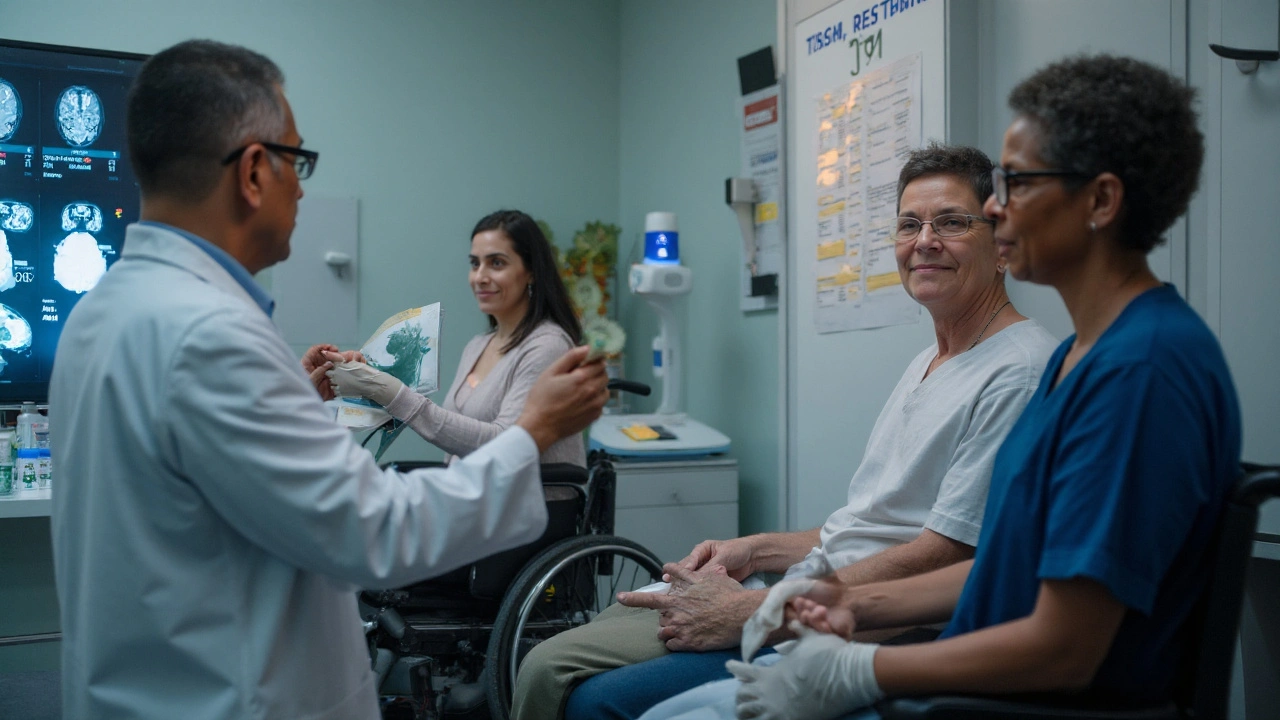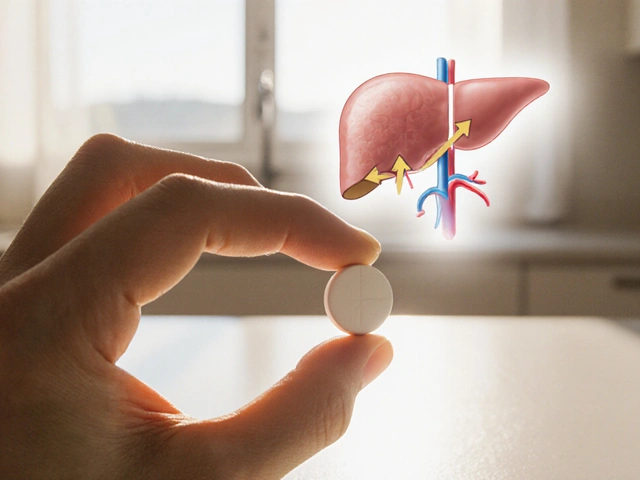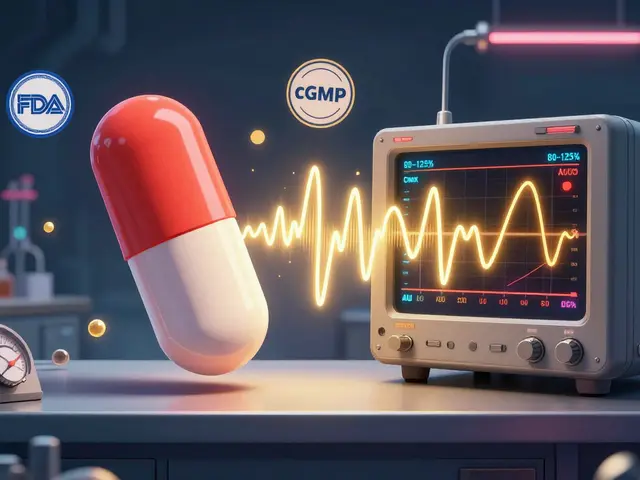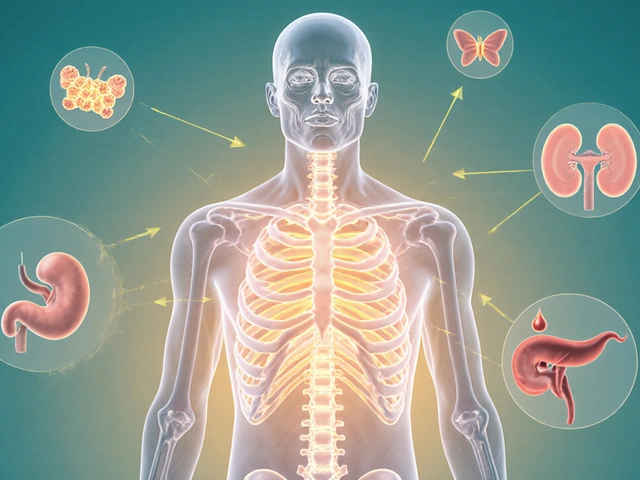
Sclerosis isn’t one disease. It’s a label doctors use when tissue becomes abnormally hard or scarred. That can happen in the brain and spinal cord, skin, blood vessels, kidneys, even bones. No wonder Google turns into a maze. This guide pulls the big conditions together, shows how they differ, and gives you a practical path from “What is this?” to “What do I do next?”
What to expect: a simple map of the most common conditions called “sclerosis,” the symptoms that separate them, which tests confirm them, the treatments that actually move the needle, and when to see which specialist. You’ll also get quick checklists, a decision tree, and a mini‑FAQ to save time at your next appointment.
TL;DR
- “Sclerosis” just means hardening/scarring. It’s a family of conditions, not one illness.
- Think systems: nerves (MS, ALS), skin/organs (systemic sclerosis), arteries (atherosclerosis), genes (tuberous sclerosis), skin-only (lichen sclerosus/morphea).
- Pattern matters. Relapses point to MS; steadily worsening weakness suggests ALS; Raynaud’s and skin tightening suggest systemic sclerosis; chest pain and risk factors fit atherosclerosis.
- Confirm with the right tests: MRI/CSF for MS, EMG for ALS, antibodies/capillaroscopy for systemic sclerosis, lipid/CAC for atherosclerosis, biopsy or clinical exam for skin conditions, genetic testing for tuberous sclerosis.
- Treatments exist for many forms-disease‑modifying meds for MS, organ‑targeted therapies for systemic sclerosis, heart‑risk lowering for atherosclerosis, and supportive/targeted options for ALS and TSC. Early diagnosis improves outcomes.
What “sclerosis” really means and why names matter
In medicine, “sclerosis” describes abnormal hardening or scarring of tissue. That scarring can come from inflammation (as in multiple sclerosis), collagen overproduction (as in systemic sclerosis), plaque build‑up (as in atherosclerosis), or genetic changes that spark tumor‑like growths (as in tuberous sclerosis). Same suffix, very different stories.
Here’s the simplest way to sort the types of sclerosis you’ll see most often:
- Brain and spinal cord: Multiple sclerosis (MS) is an immune attack on myelin, the protective coating of nerves. Amyotrophic lateral sclerosis (ALS) and primary lateral sclerosis (PLS) are motor neuron diseases-nerve cells that move muscles gradually die.
- Skin and internal organs: Systemic sclerosis (scleroderma) stiffens skin and can scar lungs, gut, and blood vessels. Localized scleroderma (morphea) hardens skin patches only.
- Arteries: Atherosclerosis builds cholesterol‑rich plaques that narrow vessels and trigger heart attacks and strokes.
- Genetic: Tuberous sclerosis complex (TSC) causes benign tumors in brain, kidneys, skin, and more.
- Other names you may hear: Lichen sclerosus (itchy, fragile genital skin), nephrosclerosis (kidney scarring, often from high blood pressure), osteosclerosis (excess bone density), hippocampal sclerosis (a scarring pattern seen in some epilepsy).
Because these conditions share a suffix, mix‑ups happen. That can delay the right referral. The goal is not to self‑diagnose but to recognize patterns fast so you land with the right specialist early.
The major categories at a glance-and how they feel different
Symptoms usually point to the right neighborhood. Use these patterns as a starting map and then confirm with tests.
| Condition | Body system | Hallmark symptoms | How it progresses | Key tests | Who to see | Typical first‑line treatment |
|---|---|---|---|---|---|---|
| Multiple sclerosis (MS: CIS, RRMS, SPMS, PPMS) | Brain/spinal cord | Relapses of numbness, vision loss (optic neuritis), weakness, balance issues; symptoms improve then return | RRMS has attacks and remissions; SPMS gradual worsening after years; PPMS slowly worse from start | MRI brain/spine with contrast; CSF oligoclonal bands; evoked potentials | Neurologist (MS subspecialist if possible) | Disease‑modifying therapies (interferons, glatiramer, fumarates, S1P modulators, natalizumab, ocrelizumab/ofatumumab, cladribine); steroids for relapses |
| ALS / PLS | Motor neurons | Weakness that spreads, muscle wasting, cramps, spasticity; speech/swallow/breathing can be affected; sensation stays normal | ALS typically progressive over months to years; PLS is slower, mainly stiffness/UMN signs | EMG/NCS; neurological exam; imaging/labs to rule out mimics; genetic testing in some | Neurologist (motor neuron disease clinic if available) | Riluzole; edaravone for some; tofersen for SOD1‑ALS; respiratory, nutrition, and communication support |
| Systemic sclerosis (limited/diffuse) | Autoimmune connective tissue | Raynaud’s (color‑changing fingers in cold), puffy to tight skin, heartburn, breathlessness; fingertip sores; telangiectasias | Variable; limited often slower; diffuse can involve lungs, kidneys, heart earlier | ANA panel; specific antibodies (anti‑centromere, anti‑Scl‑70, RNA polymerase III); nailfold capillaroscopy; lung function & HRCT | Rheumatologist; pulmonologist/cardiologist as needed | Mycophenolate or methotrexate; nintedanib for ILD; vasodilators for Raynaud’s/PAH; ACE inhibitors for renal crisis; PPI for reflux |
| Localized scleroderma (morphea) | Skin | Firm, oval plaques of thickened, discolored skin; may be linear bands in children | Usually skin‑limited; may leave pigment change | Clinical exam; skin ultrasound; biopsy if unclear | Dermatologist | Topical steroids or calcineurin inhibitors; phototherapy; methotrexate for deep/linear disease |
| Lichen sclerosus | Skin (genital/anal) | Intense itching, white fragile skin, tearing, pain with sex/urination | Chronic; small cancer risk on vulva/penis with long‑standing disease | Clinical exam; biopsy if atypical | Dermatologist, gynecologist, or urologist | Ultra‑potent topical steroids; maintenance therapy; monitoring |
| Atherosclerosis | Arteries | Often silent; chest pain with exertion, calf pain when walking, TIAs/strokes | Decades; risk depends on cholesterol, blood pressure, diabetes, smoking, family history | Lipid panel; blood pressure, HbA1c; coronary calcium score; carotid ultrasound | GP/cardiologist; stroke clinic if symptoms | Statins/ezetimibe; PCSK9 inhibitors or inclisiran in high‑risk; exercise, diet, BP/sugar control; antiplatelets when indicated |
| Tuberous sclerosis complex (TSC) | Genetic multisystem | Seizures, developmental differences, kidney angiomyolipomas, facial angiofibromas | Lifelong; varies widely | Genetic testing (TSC1/TSC2); MRI brain; renal imaging; skin exam | Genetics/neurology; nephrology/dermatology | mTOR inhibitors (everolimus) for certain tumors/seizures; surveillance |
| Other “sclerosis” terms | Kidney/bone/brain | Nephrosclerosis (from hypertension), osteosclerosis (dense bone), hippocampal sclerosis (epilepsy pattern) | Depends on cause | Targeted imaging/labs | Nephrology/orthopedics/neurology | Treat underlying cause; specialist‑guided |
Quick patterns you can trust:
- Comes and goes, then comes back in a new spot? Think MS.
- Steadily worsening weakness with muscle wasting, no numbness? Think ALS.
- Cold turns fingers white/blue, skin feels tight, reflux burns? Think systemic sclerosis.
- No symptoms, but high cholesterol and family history of early heart attacks? Risk likely sits with atherosclerosis.
- Genital itching with thin white skin? Consider lichen sclerosus-treat early to protect skin.

Diagnosis: what tests you’ll likely face and why
Getting the right label hinges on picking the right tests. Here’s what usually happens and what each result means in plain language.
Multiple sclerosis (MS)
- MRI brain and spine with gadolinium: looks for lesions in typical spots (periventricular, juxtacortical, infratentorial, spinal). “Enhancing” lesions are new; old ones are dark or non‑enhancing. Radiologists use criteria from the McDonald updates (2017 with 2021 clarifications) to show spread over time and space.
- CSF (lumbar puncture): oligoclonal bands present in most people with MS; they support diagnosis when MRI is borderline.
- Evoked potentials: measure how fast signals travel; can reveal damage you can’t feel.
- Key rule: doctors exclude mimics-B12 deficiency, infections, vascular disease, neuromyelitis optica spectrum disorder (AQP4/MOG antibodies).
ALS and PLS
- EMG/NCS: tracks electrical signals in muscles and nerves. In ALS, EMG shows active and chronic denervation in several body regions.
- Clinical exam: upper motor neuron signs (stiffness, brisk reflexes) plus lower motor neuron signs (wasting, fasciculations) point to ALS. PLS shows mainly upper motor neuron signs over years.
- Genetic testing: considered if symptoms start young, there’s a family pattern, or features suggest specific genes (SOD1, C9orf72). Tofersen targets SOD1 variants.
Systemic sclerosis (scleroderma)
- Antibody panel: anti‑centromere often in limited cutaneous disease; anti‑Scl‑70 (topoisomerase I) in diffuse disease with lung risk; RNA polymerase III carries higher renal crisis risk. Labs don’t define everything but help predict organ targets.
- Nailfold capillaroscopy: a tiny microscope shows damaged capillaries at the fingernail base-classic in systemic sclerosis.
- Lung tests: pulmonary function tests (look for reduced DLCO) and high‑resolution CT scan to spot interstitial lung disease early.
- Heart and vessels: echocardiogram for pulmonary hypertension, blood pressure monitoring for renal crisis risk.
Atherosclerosis
- Lipid profile and HbA1c: sets baseline risk and treatment targets.
- Coronary artery calcium (CAC) score: a low‑radiation CT that counts calcium in coronary arteries. A score of 0 often means low short‑term risk; higher scores push toward stronger cholesterol lowering.
- Carotid ultrasound and ankle‑brachial index: look for plaque or poor leg blood flow when symptoms suggest it.
- High‑sensitivity CRP: sometimes used to refine risk in borderline cases.
Tuberous sclerosis complex (TSC)
- Genetic testing for TSC1/TSC2 confirms most cases.
- Baseline MRI brain, renal imaging, ophthalmology and dermatology checks. Ongoing surveillance follows international TSC guidelines.
Lichen sclerosus and morphea
- Usually a clinical diagnosis. Biopsy if the pattern is atypical or not responding to standard therapy.
Sources worth knowing: for MS, the McDonald criteria and American Academy of Neurology guidance; for systemic sclerosis, EULAR 2023 recommendations; for atherosclerosis, 2022-2024 ACC/AHA and national heart foundation updates; for ALS, international ALS/MND consensus statements; for TSC, the 2021-2023 international TSC consensus surveillance guidelines. Your clinician uses these to guide testing and treatment.
Treatment pathways, self‑care, and realistic outcomes
Good news: many of these conditions have treatments that change the curve. The right plan depends on the specific diagnosis, your risk, and what matters most to you.
Multiple sclerosis
- Disease‑modifying therapies (DMTs) reduce relapses and slow disability in relapsing forms. Options include interferons, glatiramer acetate, dimethyl/diroximel fumarate, teriflunomide, S1P modulators (fingolimod/ozanimod/siponimod), cladribine, natalizumab, ocrelizumab, ofatumumab, and alemtuzumab.
- Primary progressive MS has fewer options; ocrelizumab helps some. Trials of BTK inhibitors continue in 2025 but aren’t standard yet.
- Relapse treatment: high‑dose steroids for days; plasma exchange if steroids fail in severe attacks.
- Symptom care: energy conservation for fatigue; baclofen/tizanidine for spasticity; carbamazepine/gabapentin for nerve pain; pelvic floor therapy for bladder issues; exercise and vitamin D as advised.
ALS/PLS
- Riluzole modestly extends survival; edaravone may slow decline in selected patients. Tofersen helps some with SOD1‑ALS. New drugs are being tested; ask about trials.
- Multidisciplinary care matters: respiratory support (non‑invasive ventilation), nutrition (PEG when needed), speech therapy, mobility aids, and communication devices improve quality and length of life.
- Advance care planning early reduces crisis decisions later.
Systemic sclerosis
- Skin and joints: methotrexate or mycophenolate; physical therapy to keep hands flexible; moisturizers and sun care for skin.
- Lungs: mycophenolate is first‑line for interstitial lung disease (ILD); nintedanib reduces ILD progression; rituximab or tocilizumab may be considered in selected cases per recent EULAR guidance.
- Vessels: calcium channel blockers or PDE5 inhibitors for Raynaud’s; intravenous prostacyclins for severe digital ischemia; endothelin receptor antagonists and PDE5 inhibitors for pulmonary hypertension.
- Kidneys: treat a renal crisis promptly with ACE inhibitors-this is a time‑critical emergency.
- Gut: PPIs for reflux, prokinetics for slow gut, small‑bowel antibiotics for bacterial overgrowth.
Localized scleroderma (morphea) and lichen sclerosus
- Morphea: potent topical steroids or calcineurin inhibitors for plaques; narrowband UVB or UVA1 phototherapy for widespread disease; methotrexate for deep/linear forms.
- Lichen sclerosus: ultra‑potent topical steroids induce remission; long‑term maintenance prevents scarring. Regular checks watch for rare skin cancer changes.
Atherosclerosis
- Lifestyle with targets: 150+ minutes a week of moderate activity; fiber‑rich diet (Mediterranean‑style), avoid trans fats, keep sodium modest, don’t smoke or vape nicotine.
- Medications: statins for most at elevated risk; add ezetimibe if LDL goals aren’t met; PCSK9 inhibitors or inclisiran for very high risk or familial hypercholesterolemia; control blood pressure (ACE inhibitor/ARB preferred in many), and diabetes (GLP‑1 receptor agonists or SGLT2 inhibitors help hearts and kidneys).
- Procedures: stents or surgery only when symptoms or high‑risk anatomy demand it; pills and lifestyle remain the foundation.
Tuberous sclerosis complex
- Everolimus can shrink certain tumors and help seizures; epilepsy surgery and ketogenic diet are options in selected cases.
- Regular surveillance catches kidney, brain, and heart issues early.
Real‑world tips
- Ask for a written plan: diagnosis, goals, next tests, and what would make the plan change.
- Stack small wins: 10‑minute walking blocks, one extra serving of veg, consistent sleep, stress management-boring works.
- Track symptoms weekly, not daily, so noise doesn’t mislead you or your clinician.

Quick tools: checklists, decision tree, mini‑FAQ, next steps
Red‑flag checklist (don’t wait on these)
- New weakness, vision loss, or severe imbalance lasting more than 24 hours.
- Speech slurring, facial droop, sudden one‑sided weakness-possible stroke.
- Shortness of breath at rest or chest pain with pressure or sweating.
- Blue, painful fingers/toes that don’t warm up; fingertip ulcers.
- Rapidly rising blood pressure with headache in someone with systemic sclerosis symptoms.
Which specialist and when
- Neurologist: relapsing neurological symptoms, progressive weakness, or suspected MS/ALS/PLS.
- Rheumatologist: Raynaud’s plus skin tightening, unexplained fingertip ulcers, or positive systemic sclerosis antibodies.
- Cardiologist/GP: chest pain, high coronary calcium, strong family history of early heart disease.
- Dermatologist/gynecologist/urologist: genital itching/tearing or suspected lichen sclerosus; firm skin plaques (morphea).
- Clinical genetics: features suggestive of tuberous sclerosis or a strong family pattern of neurological or cardiac disease.
Decision tree (rule‑of‑thumb)
- Are symptoms mainly neurological? If yes, go to step 2. If no, go to step 4.
- Neurological symptoms come in attacks and leave scars on MRI in different places/times? Likely MS-seek an MS‑savvy neurologist.
- Neurological symptoms are steadily progressive weakness without numbness, with muscle wasting or stiffness? Consider ALS/PLS-ask for EMG and referral to a motor neuron clinic.
- Is there skin tightening, Raynaud’s, reflux, or breathlessness? Consider systemic sclerosis-ask your GP for antibodies and nailfold capillaroscopy, and refer to rheumatology.
- Do you have chest pain on exertion or many heart risk factors? Ask for a lipid panel and consider a coronary calcium score.
- Is there intense genital itching with fragile white skin? Ask about lichen sclerosus and topical therapy.
Cheat‑sheet: tests to request (word‑for‑word)
- Suspected MS: “MRI brain and cervical/thoracic spine with gadolinium; CSF for oligoclonal bands; AQP4/MOG antibodies to exclude NMOSD.”
- Suspected ALS/PLS: “EMG/NCS across bulbar, cervical, thoracic, lumbosacral regions; MRI to rule out structural mimics; labs for B12, thyroid, SPEP; consider genetic panel if appropriate.”
- Suspected systemic sclerosis: “ANA with ENA, including anti‑centromere, anti‑Scl‑70, RNA polymerase III; nailfold capillaroscopy; PFTs with DLCO; HRCT chest.”
- Atherosclerosis risk: “Fasting lipid panel, HbA1c, blood pressure log; consider coronary calcium score (CAC) if intermediate risk.”
- Suspected lichen sclerosus/morphea: “Dermatology review; biopsy if atypical; discuss ultra‑potent steroids (lichen sclerosus) or phototherapy/methotrexate (morphea).”
Mini‑FAQ
- Is MS related to ALS? No. MS is an immune attack on nerve insulation (myelin) with relapses; ALS is loss of motor neurons with steady weakness. Different biology, tests, and treatments.
- Can atherosclerosis cause numbness or tingling? Usually no. It causes reduced blood flow. Numbness/tingling is more a nerve issue. Stroke is the exception-sudden onset requires emergency care.
- Does systemic sclerosis always involve organs? Not always. Limited disease can be mostly skin and blood vessel symptoms for years, but lungs and gut still need monitoring.
- Can lifestyle reverse atherosclerosis? Plaques can stabilize and shrink a bit with aggressive risk reduction, which is what prevents heart attacks. The aim is stability, not perfection.
- Are there cures? Not yet for MS, ALS, or systemic sclerosis. But MS has many disease‑modifying options; systemic sclerosis has effective organ‑specific therapies; ALS care improves quality and duration of life. Early, targeted care matters.
Next steps by persona
- “I’m having relapsing nerve symptoms.” Call your GP for an urgent neurology referral. Ask for MRI brain and spine with contrast and basic bloods to rule out mimics. Track symptom start/stop dates.
- “My fingers change color in the cold, and my skin feels tight.” Book rheumatology. Request ANA with specific antibodies and nailfold capillaroscopy. Keep hands warm; avoid nicotine and vibration tools.
- “Heart disease runs in my family.” Ask your GP about a Heart Health Check, lipid panel, and coronary calcium score if you’re in an intermediate‑risk bracket. Start daily walking now.
- “Persistent genital itching.” See a GP or dermatologist; ask about ultra‑potent topical steroids and long‑term maintenance for lichen sclerosus. Don’t delay-early treatment prevents scarring.
- “We suspect tuberous sclerosis in our child.” Request genetics referral and a coordinated surveillance plan (brain MRI, kidney imaging, eye and skin checks). Ask about everolimus if growths are causing problems.
Common pitfalls to avoid
- Chasing every supplement before you have a firm diagnosis. Get the right tests first.
- Letting a normal early test stop the work‑up. MS and systemic sclerosis can hide early-follow‑up matters.
- Ignoring silent risks. Atherosclerosis builds quietly; your numbers tell the story before symptoms.
- Stopping topical steroids too soon in lichen sclerosus. Maintenance keeps skin healthy.
Where the evidence stands in 2025
- MS: Early, high‑efficacy therapy improves long‑term outcomes (AAN and international MS society statements). BTK inhibitors are still in trials.
- ALS: Multidisciplinary clinics extend survival; riluzole and edaravone help selected patients; gene‑targeted therapy exists for SOD1‑ALS.
- Systemic sclerosis: Mycophenolate is first‑line for ILD; nintedanib slows lung function decline; vasodilators reduce vascular complications (EULAR 2023).
- Atherosclerosis: Lower LDL, lower events-statins remain backbone; non‑statins for higher‑risk tiers (ACC/AHA guidance).
- TSC: mTOR inhibitors shrink lesions and help seizures; structured surveillance prevents crises.
If you’re unsure where you fit, bring this page to your GP and circle the pattern that sounds most like you. The fastest path to answers is the right specialist, the right tests, and a clear plan you can stick to.
Kristy Sanchez
So let me get this straight - we’ve got a whole family of diseases named after ‘hardening’ like it’s some kind of weird culinary trend? ‘Here’s your sclerosis, ma’am, extra crunchy with a side of organ failure.’ I mean, if you’re gonna label things by texture, why not just call it ‘tissue tofu’ or ‘nerve concrete’? At least then we’d know what we’re eating.
And don’t even get me started on how MS and ALS get lumped together like they’re siblings in a medical soap opera. One’s your brain throwing a tantrum, the other’s your motor neurons doing a slow-motion suicide. Same suffix, totally different trauma.
Also, someone please tell me why ‘sclerosis’ sounds like a villain in a 90s sci-fi movie? ‘Behold! I am Scleross, Lord of the Stiffened Spine!’
Meanwhile, my grandma thinks she has ‘skin sclerosis’ because her knuckles crack. She’s got arthritis, honey. Not a dystopian autoimmune epic.
But hey, at least now I know to Google ‘Raynaud’s’ and immediately assume I’m dying. Thanks, medicine. You’re a real lifesaver.
And yes, I’m still waiting for the ‘sclerosis’ themed Netflix series. I’ll binge it while I cry into my statin pills.
Michael Friend
The entire premise is flawed. You can’t reduce complex neuroimmunological and fibrotic disorders to a single suffix and expect people to navigate them with bullet points. This is medical reductionism at its most dangerous. The table is overly simplistic, the decision tree ignores overlap and comorbidity, and the ‘quick checks’ encourage self-diagnosis under the guise of empowerment. You’re not helping - you’re creating a generation of anxious Googlers who think a CAC score replaces a cardiologist.
Also, no mention of the systemic inequities in access to neurologists, rheumatologists, or genetic testing. You treat diagnosis like a checklist, not a social determinant. This isn’t a guide - it’s a corporate wellness pamphlet dressed up as clinical wisdom.
Jerrod Davis
While the structural organization of this document is commendable, and the inclusion of diagnostic criteria from authoritative guidelines such as McDonald 2017 and EULAR 2023 is methodologically sound, the casual tone and colloquial phrasing undermine its clinical utility. The use of phrases such as ‘Google turns into a maze’ and ‘you’ll land with the right specialist early’ lacks the precision expected in medical communication. Furthermore, the TL;DR format, while popular in digital media, risks trivializing conditions that require lifelong, multidisciplinary management. A more formal register would better serve the intended audience of patients seeking authoritative guidance.
Dominic Fuchs
Hardening? Yeah that’s what happens when your body gives up on being soft and just decides to go full concrete
MS is your nerves having a meltdown and your immune system showing up to the party with a flamethrower
ALS is your motor neurons just… quitting their jobs one by one
And atherosclerosis? That’s just your arteries throwing a cholesterol rave and forgetting to clean up
Meanwhile lichen sclerosus is just your genitals going ‘nope’ and turning into parchment paper
Why do we name diseases like they’re bad breakup texts?
Anyway the real takeaway is this - if your body feels like it’s turning into a statue, don’t panic. Just find the right specialist before you start Googling ‘can you live with scleroderma and still enjoy tacos’
Asbury (Ash) Taylor
This is exactly the kind of resource people need when they’re scared and overwhelmed. You took a terrifying jumble of medical jargon and turned it into something human. That’s not just helpful - it’s healing.
For anyone reading this who’s just been told ‘you have sclerosis’ - breathe. You’re not alone. There are treatments. There are specialists. There are people who’ve walked this path before you.
And if you’re reading this because you’re trying to help someone else - thank you. Your curiosity is a gift. Keep asking questions. Keep showing up. The right care is out there, and you’re already on the right path just by seeking it.
Small steps. One day at a time. You’ve got this.
Kenneth Lewis
ok so i read this whole thing and now i think i have like 4 types of sclerosis??
my fingers get cold = raynaud’s
my back hurts = spinal sclerosis??
my dad had a heart attack = atherosclerosis
and i got a weird rash last summer = lichen sclerosus??
also my dog just licked my foot and now i think i have osteosclerosis from the dog saliva
brb going to google ‘can you have all sclerosis at once’
ps: i think the ‘decision tree’ should have a step that says ‘did you just panic because of a 10 minute google search’
pls send help or at least a cookie





Write a comment